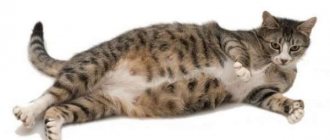Over time, our relationship with cats changed... There was even a time when people burned them at the stake (along with “witches”) - believing that they were in connection with the other world. Being within the framework of superstitions and myths, we avoided and feared them.
But over time, this soulful look, fluffy and beautiful fur, funny mustache and cheerful disposition melted our “cold heart”, and now we live with cats under the same roof.
Psychology of cats. People who love cats
Everyone has their own hobbies: some people like to spend time watching TV series, others prefer active recreation or knitting, and some people love to caress cats, play with them, and talk as if they were talking to a person. Therefore, all cat lovers have common character traits, and psychological science provides an explanation for this. The cat symbolizes both independence and devotion, character and strength and affection, grace and fragility. People love cats because they either have certain cat-like traits or want to have those traits.
Surely, in recent years, you have noticed that the number of cat lovers’ communities on the Internet has increased. There are a lot of funny pictures and videos dedicated to your favorite pets. This is explained by the fact that the cat symbolizes home comfort, happiness and tranquility. Recently, people have been focused on living comfortably and happily, and a lot of effort and resources are spent on this. And if there is also a cat in the house, happy, well-fed, affectionate, then life is good.
Cats are loved because these animals love tactile contacts: you can stroke them, scratch them behind the ears, caress them, and fall asleep with them. In this way, modern people relieve stress and make up for the lack of love and tenderness.
The cat symbolizes home comfort, happiness and tranquility
Interesting fact! Very often you can notice that young couples in love who begin to live together, first of all, have a cat in the house, and only years later children. This is explained by the fact that a cat does not require much attention and young people subconsciously perceive a cat as a child. After a while, people become convinced of the strength of their union and decide to have a baby.
Why love them
Happiness, tranquility, family comfort - this is what this pet symbolizes. If there is a cat in the room, it is always nice. Tactile contacts are the best anti-stress and an excellent sedative. It’s so nice to scratch behind the ear and snuggle up to a warm body:
- there is no hassle with him. Eats little, does not require walks;
- freedom-loving, but loves to be caressed and pampered;
- warm and affectionate.
Women and cats are very similar. Modern ladies are also bold and graceful. They know how to show their “claws” if necessary. Grace, sexuality and beauty are their common features. Women who love to dress up cats in shiny and bright clothes project character traits that are inherent in ladies onto their pets.
Why do women love cats so much?
Exquisite women's tattoos depicting a graceful slender cat are very popular. It is obvious that for modern women the cat is the embodiment of feminine nature, beauty and sexuality, elegance and grace. Such women make it clear that they are not only beautiful, but also daring and vindictive, who know how to show off their “claws” when the occasion is right. Projecting their own, truly feminine character traits onto the cat, representatives of the fair sex love to buy shiny jewelry and tickets to specialized exhibitions for cats. In this way, women assert themselves and increase their self-esteem.
Cat Personality Traits
Idea! Therefore, if you are communicating with a woman who really loves cats, ask her a few questions about the character of her pet. A woman will be happy to talk about her favorite, and you will know that much of what is mentioned is present in the character of the woman herself.
Psychological facts
Forgiving early wake-ups in the morning, scratches on legs, the habit of using furniture instead of a scratching post, and other “charms” of having a cat in the house allows for something more that these pets give in return. People like them because they allow:
- Get the "source" of daily fun. In terms of their ability to amuse people, cats are unlikely to have many competitors, because they are able to take funny, touching poses, fall asleep in unexpected places, and create other reasons for smiling.
- Give your care. Sometimes you might think that one of the main purposes of a cat is to be an object of care and love. Their main weapon is a muzzle with a neat nose and big eyes, soft fur that you constantly want to stroke and squeeze - even adults “turn on the love” for these animals.
- Heal your “sore” places. Bioenergeticists are confident that the positive aura of cats helps relieve fatigue and migraines, has a beneficial effect on normalizing blood pressure and pulse, and reducing pain in diseased internal organs.
- Feel needed. Cats sense well when their owner is upset and angry, so they are ready to come to him for comfort. At the same time, their purring acts as a sedative. It’s not for nothing that they say: a dog is a friend of man, a cat is a friend of the soul.
- Think about literary works. In different eras, Russian writers made these animals the main characters of their works, endowing them with intelligence and cunning. Just look at the cat Behemoth from “The Master and Margarita” by M. Bulgakov or the scientist cat from Lukomorye by A. Pushkin.
- Awaken or realize parental instincts. It is their manifestation that serves as a source of love for cats and care for those who need it. In addition, meowing is sometimes called mimicry of a child's cry. Indeed, life with these pets is in many ways reminiscent of life with a child, although for some, such “humanization” of animals is perceived as a surrogate for motherhood.
- Remember femininity. For some, a cat's grace, grace, beauty, and the ability to “show her claws” at the right time are the embodiment of feminine nature. It’s not for nothing that cat tattoos are one of the most popular themes.
Scientists studying human and animal behavior believe that love for cats is genetically determined. In ancient times, large felines posed the greatest danger to people, so it was important to monitor them and study their habits. And love and admiration have already become a by-product of such observations and have been consolidated over many years of coexistence.
Likes of the cat family: what kind of people do cats like and why?
Cats love it when people show them attention and care. Pay attention to street cats, how they crave communication and affection, how they rub against the legs of a random passerby who calls out to the animal. Domestic cats receive a lot of attention every day, so they are more selective in their contacts.
Cats love to show attention and care towards them.
You've probably heard the expression “animals look like their owners.” Often, a cat will choose one family member whom it considers its true owner, even if other people treat it well. Psychologists say that a cat will prefer a person who gives the animal his love and care, but does not require reciprocal expressions of feelings, does not force the animal to caress, play, or sit on his lap. Each cat has its own temperament, character and preferences, so it chooses the person who is most similar to itself.
Cats don't like rude, unkind people. However, if a cat lives in a family where it is not well cared for, in most cases it will still strive to communicate - this is its nature. Cats know how to forgive their owners. Some breeds, for example, Siamese, have a special character: proud, independent, aloof. Such animals rarely strive to communicate with people and do not like tactile contacts, even if the owner is kind and affectionate. This does not mean that the animal does not like you, it’s just that his psyche is structured this way.
When did cats appear in human life?
Advice! Therefore, when choosing a kitten for your family, you should take a close look at its character. If the cat is purebred, you need to study the characteristics of this species to avoid disappointment.
Control your behavior
- You shouldn’t be overly intrusive towards your cat, respect his wishes and don’t force him to do something he doesn’t want to do at all.
- Don't look your cat in the eye when you first meet him. You should not approach a cat looking straight into its eyes if you are trying to get to know it or make first contact. Wait for the cat to approach you.
- Don't tower over the cat. Lower your shoulders, place your hands on your knees and sit down on the floor. This way the cat will understand that you are its ally, and not a huge moving block that poses a danger.
- Do not make noise. Speak very quietly. Keep noisy children or dogs away during the first moments of acquaintance.
- Don't reach out. Once your cat gets used to your presence, you should secretly let her sniff your hand. The fingers should be relaxed or move slowly. You should not bring your hand to the cat sharply, directly to the nose, he may see this as a danger signal.
- Take your time. You need to be careful with your cat to avoid getting painful scratches or bites. You need to gain her trust gradually. If a previously unfriendly cat allows you to pick her up, do not rush to squeeze her and hold her by force. If he wants to leave, let him go. But you are on the right track. You can stroke the cat behind the cheeks or under the chin to teach it that human hands are not dangerous for it. Even if your cat rubs up against you, it's not necessarily an invitation to pet her immediately, says Nagelschneider. If you take the initiative too early, you may lose your cat's trust."
- Do not give up. "If the cat runs away, you haven't lost the game, but you have lost the round," Galaxy says. You shouldn’t give up and give up, the cat also needs someone to love and care for it, repeat careful attempts to get closer, and they will definitely bear fruit.”
How to tell if a cat loves you
Cats have a unique language with which they “talk” to people. Every owner must learn to understand the mood of their pet so that their connection is strong and mutual. To express sympathy and love, cats have a whole arsenal of facial expressions and gestures:
- Purring.
- Licking.
- The desire to spend all the time together.
- Falling asleep on your knees and in the same bed.
- Showing belly and tail.
- “Butting”, rubbing against arms and legs.
- Sharpening claws on furniture.
- “Massage” with claws and trampling on the body.
- Surprises and gifts.
10 signs a cat loves you
What do cats like?
Cats have their own preferences and every owner should know about them if he wants his coexistence with his pet to be filled with happiness.
Every living creature has its own preferences, and cats are no exception in this regard. The forms of these preferences can be very different from the simplest and most understandable (of course, from a human point of view), to the strange and exotic. First of all, our furry pets love, of course, everything that brings them a charge of good impressions, such as affection, tenderness, good care and appropriate nutrition. However, besides this, there is something else that all owners of these animals should know about, from those who have long been the owner of a cat to those who only intend to join the ranks of cat lovers.
The first thing that all cat lovers should pay attention to is that cats simply dote on warm places. Even if the house is warm and the pet’s thermoregulation is fine, they will not ignore a place where at least one ray of sun or the light of an electric lamp falls. The same applies to all objects that radiate heat. This is what attracts a cat to the keyboard of a laptop or computer: the owners may not notice it, but cats know for sure that it radiates heat. The same goes for cozy armchairs and sofas, radiators and window sills, and even chairs and stools occupied by the owners. Knowing this, you shouldn’t drive your comfortably settled pet away from these places every time - let him enjoy his life as a cat. True, such a love for warmth sometimes takes frankly extreme forms, and this also needs to be taken into account. For example, some owners who did not train their pets to walk around kitchen tables and appliances a hundred miles away and through the forest noted that cats tend to bask next to the switched-on burners of electric and even gas stoves, being so carried away by this process that the sound of the fire was constantly heard in the kitchen. the aroma of burnt wool. Other cats stubbornly strove to sleep on still-warm pots of cooked food, which also did not cause much delight among the owners, and still others simply almost never got off the radiator.
Of course, the owner must fight extreme manifestations of a cat’s craving for heat, since this can be dangerous for the appearance and life of the pet (some cats that are particularly addicted to the stove have even scalded themselves trying to jump on a hot kettle). An ardent love for radiators may not seem so dangerous, and to some extent this is true, but it is better to stop it, since cats constantly lying around in the heat very quickly lose their appetite and interest in games. As a result, their body weight falls, their muscles lose tone, the quality of their coat rapidly deteriorates, and eventually their internal organs begin to fail. Therefore, while respecting your cat’s love for warmth, do not allow her to become “heat dependent.”
Another favorite thing for cats is eating together. Simply put, they like to eat when their owner eats. By the way, even having their own table and diet, they almost never refuse to try food from the “master’s” table, with the exception of only those cases when they are offered some kind of product that is completely unsuitable for food, from a cat’s point of view.
They also really like it when their coat is combed, clean and shiny. It would seem that everything is as simple as shelling pears - just take it and comb it. But, despite their passion for an ideal appearance, cats are also distinguished by their willfulness, and therefore, in order to carry out all the necessary procedures (untangling or cutting out tangles, combing fur, etc.), the owner must catch the right moment. Simply put, the cat must give the go-ahead to all manipulations carried out on it, without becoming like the victims of Hitler’s experiments.
Further, in the list of cat preferences, we can mention house plants, which a rare cat will refuse to taste or even chew lightly, believing that the plants on the windowsill grow especially for her. Our furry pets are especially fond of young and tender sprouts, which, after chewing at first, the cat will definitely vomit on the floor or carpet. In this case, the owner should not rush to scold or punish his pet: it is quite possible that he is experiencing a lack of some important microelement. If a cat stubbornly strives to eat a home flower, it is advisable to discuss this issue with a veterinarian. And in order for the cat to have something to indulge in its passion for flora, plant cat grass for it.
Cats also love to have a clean, dry, and always accessible litter box. Moreover, this applies not only to purely apartment animals, but also to those who have the opportunity to freely go outside.
Another passion of cats is rock climbing, or rather furniture climbing. It's rare that a cat can resist climbing to the very top of a cabinet or refrigerator. Sometimes the matter is not limited to furniture and cats begin to climb curtains and drapes, which usually causes extreme indignation in the owner. In order to somehow get around this problem, it is better to immediately purchase a climbing frame on which the pet could relax without harming the home decoration.
Of course, it’s worth mentioning the cat’s tendency to sharpen its claws on wallpaper or sofas, which can mostly be solved by purchasing one or more scratching posts. However, often cats do not so much sharpen their claws on furniture as simply cling to something soft with them and stretch, arching their backs. In this case, you also need to let the animal understand that this is not the most suitable place. In this case, it is better for the owner to have a spray bottle of water on hand. This water therapy will allow your cat to form an associative connection between this place and the water splashes, so she will most likely soon find a more suitable place for sweet stretches.
Cats are very dexterous and graceful creatures, and human concepts of material damage are completely alien to them, so they can often be seen maneuvering like a snake between various fragile things, such as glasses or crystal vases, etc.
Of course, if the cat is prevented from enjoying sleep, it will show dissatisfaction. Even if she lay down on your lap to sleep for some 3-5 hours, is this really a reason to interrupt her royal rest? She has the right to restore her strength. Therefore, try not to disturb your cat without reason. And we are talking not only about physical, but also about sound impact. Sharp screams, door slams, and the like make the cat very nervous and can also deprive them of sleep.
All guests should be aware of the cat's preferences, so they should regularly bring something the cat will like. At the same time, they should not impose their tenderness on the animal until it itself asks them about it.
But probably the purr’s greatest love is hunting. And it almost doesn’t matter what it will be - a paper ball, a small ball, a low-flying bird or a good old mouse. Therefore, in order for this animal to retain its grace and maintain its shape, spend at least a couple of play sessions with it a day.
How to make friends with a cat?
The easiest way to make friends with a cat is at an early age, because the kitten perceives the person who feeds, cares and caresses it as its mother. Over time, the owner and kitten “get used to” each other, they develop joint fun and traditions. If an adult cat for some reason dislikes a person, she will not want to spend time with him and will refuse to accept his attention. In such cases, you can try to make friends with the cat, although this process is long and will require patience from you.
- Try to create the most comfortable conditions for the animal: a cozy bed, good food, periodic treats, interesting toys.
- Do not perform actions that the animal may perceive as an act of aggression: do not shout, do not make sharp hand gestures, do not create noise and a nervous environment in the house, do not throw the cat during games.
- Cats can remember an insult for a long time and, on occasion, take revenge on the owner, so treat the animal with respect: do not disturb it while sleeping, do not take food, do not scream, and do not hit it under any circumstances.
- Study special literature on the topic of cat sign language. This way you will begin to understand what mood the cat is in and what she wanted to get from you. For example, if you see that the animal has flattened its ears and retracted its head, it is better to leave it alone. And if the cat looks at you intently, blinks and moves towards you, it’s time to pet it.
Cats can remember an insult for a long time and, on occasion, take revenge on their owner.
When the cat understands that you are not a threat to it and are friendly, over time it will begin to trust you.
Advice! If you are unable to make friends with a cat, despite all your efforts, try contacting an animal psychologist or, for example, finding thematic groups of cat lovers on social networks. Experienced breeders will not refuse you useful advice.
Nanny cats
Cats love to sleep in beds with babies because they smell like mother's milk. It is possible that cats also like a soft and cozy baby bed. Of course, you should not allow a cat to be in bed with a baby: it is not hygienic. In addition, the animal may accidentally scratch the child.
Cats are very kind and caring towards small children.
When the baby grows up, there is no need to limit his communication with the soft fluffy ball. Young children love cats because they are interested in an animal that is active and loves to play and jump. Some children love to pet cats, subconsciously perceiving them as their mother - gentle and affectionate. Young children may not always be able to clearly understand and explain their feelings of frustration, resentment, or fatigue. But those children who have a furry pet in the house endure stress much easier. You can pet the cat and listen to its purring, after which you will feel calm and peaceful.
Some cats are very kind and caring towards small children, show them their love in every possible way and try to spend a lot of time together. Parents from an early age should teach their child to communicate correctly with a cat, then this friendship will bring a lot of positive emotions for all family members.
The cat sees its owner as a protector
Another reason why a cat goes to bed with a person is the desire to be protected. Oddly enough, cats sometimes experience fear and anxiety. If the animal sleeps poorly when alone, often wakes up and even meows, offer her a place near you.
Sometimes mother cats drag their babies into bed with their owner precisely because they consider the place next to the person the most comfortable and safe. Be careful around furry babies, don't crush them.
If your cat sleeps on you or in your bed, do not forget about animal hygiene. Unfortunately, many cat diseases can be dangerous to humans.
Character and temperament of cats
A cat's temperament is the totality of an animal's reactions to external stimuli. This is an innate quality that practically does not change over the course of life. The character of a cat can be changed by forming certain habits in it. However, many commonalities can be found in the behavior of cats.
Interesting facts about cats
Researchers from the UK conducted a survey of more than 200 cat owners, as a result of which they were able to identify a typology of cat characters:
| Type | Image | Description |
| Cat-man | Ideal for living with a family, in the company of people. She strives to spend as much time as possible with her owners and is actively interested in their affairs. | |
| Hunter cat | Loves to play with his owners or with toys. This is the same type of cat that suddenly attacks its owners from around the corner, listens to all suspicious sounds, actively plays and jumps. The ideal place of residence for such an animal would be a country house or rural area. | |
| cat-cat | Shows an active interest in representatives of his kind. Such animals will be very happy if another animal appears in the apartment. | |
| feisty cat | Does not like tactile contact, does not play with owners and does not communicate with other animals. She makes contact only when she wants it. | |
| Curious cat | He is distinguished by his investigative disposition and studies surrounding objects, people and animals with interest. Loves to explore and smell new things, meet new people and animals |
Relationships between cats and dogs
The proverb “like a cat and a dog”, which has long been known to all of us, does not always turn out to be true. Indeed, these animals do not get along well with each other, this can be especially clearly observed in the relationship between street cats and dogs. At home, you can keep a cat and a dog at the same time if you raise them correctly. True friendship between these animals is unlikely to happen (although there are exceptions), but living together is quite possible. It is desirable that each animal has a place where it can retire and relax.
Relationships between cats and dogs most often do not work out due to differences in personalities and temperaments, as well as in body language. Using the table, you can clearly assess how great the difference is in the behavior of these animals.
How to introduce animals and help them bond
Differences in body language between cats and dogs
| Sign language | Cats | Dogs |
| Image | ||
| Tail held high | Friendliness, calmness, confidence | Anxiety, vigilance |
| Tail wagging | Indignation, indignation | Delight, joy |
| Closed mouth | Normal condition | Tension |
| drooping ears | Wariness, dissatisfaction | Joy, humility |
| Body tilt to the side | The desire to appear more aggressive and stronger than the enemy | Indicator of victory in a conflict situation |
| Supine position | Indicator of trust in a person | Desire for affection from the owner |
| Back arch | Self-defense, gesture used during hunting | Playful mood |
Bioenergetics of humans and cats
Communication with a cat is a great way to not only relieve stress and improve your mood, but also an opportunity to alleviate the symptoms of many diseases. Cats have unique energy and increased sensitivity; they can independently determine the area of the human body that needs treatment. Cat therapy is carried out using purring, gentle “massage” with claws, and warming the diseased area of the body with warm fur.
Relationship between cats and humans
Cats are best able to help people suffering from high blood pressure, insomnia and neurological diseases, colds, bone and joint diseases, and cardiovascular diseases. Cats know how to restore a person’s energy balance, as well as cleanse the home of bad energy.
Some cats sense places in the apartment that are unfavorable from a bioenergy point of view. Perhaps you yourself have noticed that none of the family members, for whatever reason, wants to sit in the farthest chair in the hall, and always chooses another place to rest. Nevertheless, the cat always chooses this particular chair and lies in it in the “sphinx” position, with its front legs extended and its hind legs tucked. In this way, the cat cleanses our house of bad energy, making it cozy and comfortable for all household members.
On a note! The cat is one of the most ancient inhabitants of the human home. Do not deny yourself communication with a little fluffy ball, this animal will give you a lot of joy and happy moments spent together.










